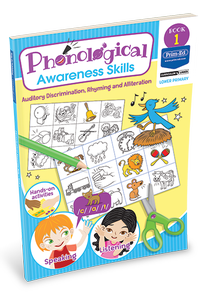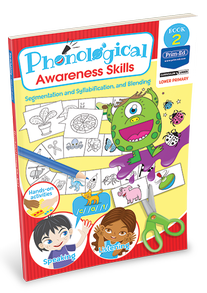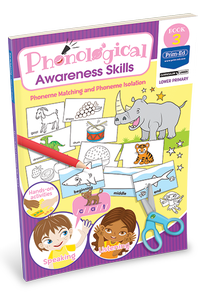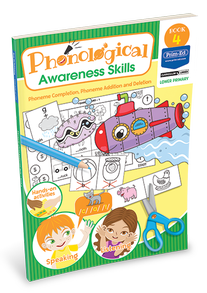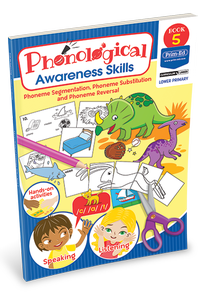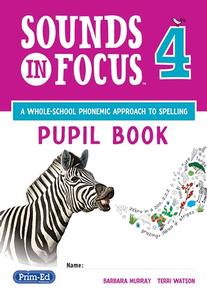-
0
Your cart is currently empty.
-
0
Your cart is currently empty.
Phonics Worksheets & Workbooks
Unlocking the magic of words and language is a journey every child embarks on and phonics is a critical key to this quest. As a teacher, you hold this key, and with the right resources, you can help your pupils unlock their potential in language learning and become independent readers.
Important resources include phonics worksheets and phonic books, which are practical and engaging tools that make the process of teaching and learning phonics enjoyable and effective. That said, let's explore what phonics is, why it is important, the different phonics sounds and how you can use Prim-Ed Publishing's phonics resources to support your teaching.
What is phonics?
Phonics is an instructional approach that facilitates the development of learners' phonemic awareness — an essential skill encompassing the ability to perceive, recognise and manipulate phonemes. Its primary purpose is to establish the connection between these sounds and the corresponding spelling patterns (graphemes) that represent them.
In simple terms, phonics is based on the idea that a language has a systematic relationship between sounds (phonemes) and symbols (graphemes). By learning the correspondence between phonemes and graphemes, pupils can apply this knowledge to read and write new words.
The importance of learning phonics
Phonics play an integral role in building a pupil's reading skills, bridging the gap between recognising and understanding words. Besides enhancing reading ability, phonics helps children spell better by enabling them to break down words into smaller sounds and write them out. Consequently, it boosts their writing skills, enriches their vocabulary and nurtures a love for reading.
What are the different phonics sounds?
Phonics sounds can be categorised into different groups depending on their characteristics. Some of the common categories are:
- Vowels and consonants: Vowels sounds are produced with an open vocal tract, such as /a/, /e/, /i/, /o/, /u/. Consonants are the sounds that are produced with a partial or complete closure of the vocal tract, such as /b/, /d/, /f/, /g/, /h/.
- Short and long vowels: Short vowels are the initial sounds that are pronounced with a short duration, such as /a/ in cat, /e/ in bed, /i/ in sit, /o/ in dog, /u/ in sun. Long vowels are the sounds that are pronounced with a longer duration, such as /a:/ in car, /e:/ in see, /i:/ in lion, /o:/ in boat, /u:/ in music.
- Digraphs and consonant blends: Digraphs are two letters that make one sound, such as /sh/ in ship, /th/ in thin, /ch/ in chat, /ng/ in ring, /ee/ in feet. Consonant blends are two or more letters that make two or more sounds, such as /bl/ in blue, /st/ in star, /tr/ in tree, /fl/ in fly, /oi/ in boil.
- Diphthongs and r-controlled vowels: Diphthongs are two vowel sounds that are pronounced as one sound, such as /ai/ in rain, /au/ in cow, /oi/ in coin, /ou/ in mouse, and /ea/ in bread. R-controlled vowels are vowel sounds influenced by the letter r that follows them, such as /ar/ in car, /er/ in her, /ir/ in bird, /or/ in for, /ur/ in fur.
- Silent letters and split digraphs: Silent letters are written but not pronounced, such as k in knife, w in write, b in lamb, g in sign, e in have. Split digraphs are two letters that make one sound but are separated by another letter, such as a-e in cake, i-e in bike, o-e in bone, and u-e in cube.
Resources in the Prim-Ed Publishing phonics resources range
Prim-Ed Publishing offers a range of phonics worksheets and resources to support teachers and pupils in learning and practising phonics skills. These resources include:
- Phonics Worksheets: These books provide a variety of activities to reinforce phonics skills for each sound group. The activities include matching, sorting, tracing, writing, colouring, reading and spelling. Phonics worksheets can be used for independent work or homework.
- Key Word Sentences: These books provide sentences that use keywords from each sound group. The sentences help pupils to apply their phonics skills to read and write meaningful texts. The three book series also include comprehension activities, questions and writing prompts to develop pupils' understanding and expression.
- Digraph Sounds and Comprehension Stories: These books provide exciting stories that focus on specific digraph sounds. The stories help pupils practise their phonics skills and fluency and comprehension. The books also include activities to reinforce vocabulary and grammar.
Teaching phonics skills in the classroom
Teaching phonics skills requires a balance of explicit instruction and meaningful practice. Teachers can use various strategies, methods and activities to teach phonics skills in the classroom. Some of the suggestions are as follows:
- Use a systematic and explicit approach to introduce new sounds and words. Explain the alphabet sound-symbol relationship clearly and model how to correctly pronounce and write all the initial sounds and words.
- Provide ample opportunities for pupils to practise their phonics skills through various activities. Use a mix of individual, pair, group and whole-class work to engage pupils and cater for different learning styles.
- Use a variety of resources to support phonics learning and build reading stamina. Use Prim-Ed Publishing phonics resources and other materials such as phonics worksheets, flashcards, games, songs, poems, stories, etc.
- Integrate phonics with other language skills and domains. Use phonics skills to support oral language development (e.g., by asking questions), reading comprehension (e.g., by predicting words), writing composition (e.g., by brainstorming words), grammar (e.g., by identifying word classes) and alternative spellings and vocabulary (e.g., by explaining word meanings).
- Assess pupils' phonics skills regularly and provide feedback. Use formal and informal assessments to check pupils' understanding and progress. You could use Prim-Ed Publishing assessment tools or create your own tests or quizzes. Provide positive and constructive feedback to pupils and help them set goals for improvement.
Phonics worksheets and resources to engage beginner and reluctant readers
In conclusion, phonics is an essential component of the English language curriculum, equipping pupils with the necessary skills for reading and writing. At Prim-Ed Publishing, we are dedicated to providing high-quality resources to support this important aspect of education. Explore our phonics worksheets and more today. For more information, check out our English resources and browse through our blog for more insights.
Frequently asked questions
What is phonics in primary education?
In primary education, phonics serves as a pedagogical approach employed for the instruction of reading and writing in the English language.
How can phonics worksheets support the Primary Language Curriculum?
Phonics worksheets can support the Primary Language Curriculum by offering an interactive and hands-on approach to learning. They can help reinforce the phonics instruction provided in the classroom, providing practice that helps pupils master different phonics sounds and their usage. Worksheets like the ones offered at Prim-Ed Publishing are designed to align with the curriculum objectives.
How do you teach phonics in the classroom?
Phonics can be taught in the classroom through a variety of methods. This includes explicit instruction, interactive activities and blending games. A teacher can use phonics worksheets and phonics books, like the ones offered by Prim-Ed Publishing, to enhance their lessons and offer diverse ways of learning.
